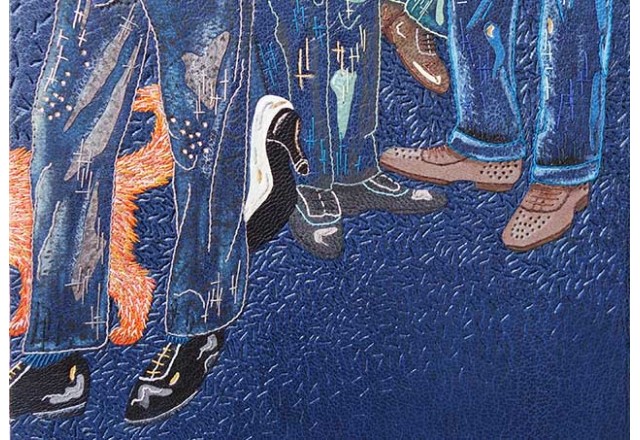The first interview on the blog was conducted back in February 2013 with the very talented Hannah Brown. Over the past four years, her work has really matured in both design and technique. So over the course of April, I’ll be catching up with Hannah by featuring work made over the past four years. Let’s start with one of my favorites, bound in 2014 is Hannah’s copy of Truman Capote’s Breakfast at Tiffany’s.
Bound in dark blue goatskin with a variety of leather onlays in grey, black, brown, green, blue, cream and orange. The design is then amplified through the use of machine and hand embroidery, as well as areas that are sanded and painted with acrylics. Texture has been added to the binding through the use of blind and gold tooling. Hannah received the Mansfield Medal for Best Book in Competition in the 2014 Designer Bookbinders Annual Competition.
The design on the binding for Breakfast at Tiffany’s combines a range of techniques that include machine and hand embroidery, painting, onlay work and tooling. I would love for you to speak about working through such a complex design. Are you planning each stitch and every painted element beforehand or are you working in a spontaneous way?
For every binding I do I make a sample board of a small section of the design. I have done this since my very first binding and now have a extensive physical archive of all my books to date. I started making these sample boards for a few reasons, mainly it was to test out colours, but given I now have quite a collection they are an invaluable aid for teaching purposes and for showing to clients.
The sample board tends to be the spontaneous part of my working process as I use it to test out colours and stitches ahead of working on the binding itself. I certainly don’t plan every stitch but do try and work methodically through the design when it comes to the embroidery work, executing the outlines first before filling in the gaps with more intricate embroidery.
With Breakfast at Tiffany’s I worked through the same method as with all of my bindings. The onlays had to be applied first so the leather could be back-pared ahead of the embroidery. The next step was brushing on the paints and the whole thing was then brought to life with the needlework by adding the outlines, adding tonal colours and securing down the onlays with stitches. I have different tracing paper templates for each stage of the process to ensure everything gets put in the correct place. The last thing is the tooling as of course this is done once the leather is on the book.
I am not a huge fan of drawing people so for this particular binding I thought a good way around this was by just depicting the legs. Because this book was for the Designer Bookbinders Annual Competition I was working to a tight deadline therefore I incorporated a lot of machine embroidery for the outlines of the legs first (for speed) and then hand-whipped these stitches afterwards. I was very happy with this method for this particular binding as I was able to put the cover design together more speedily.



